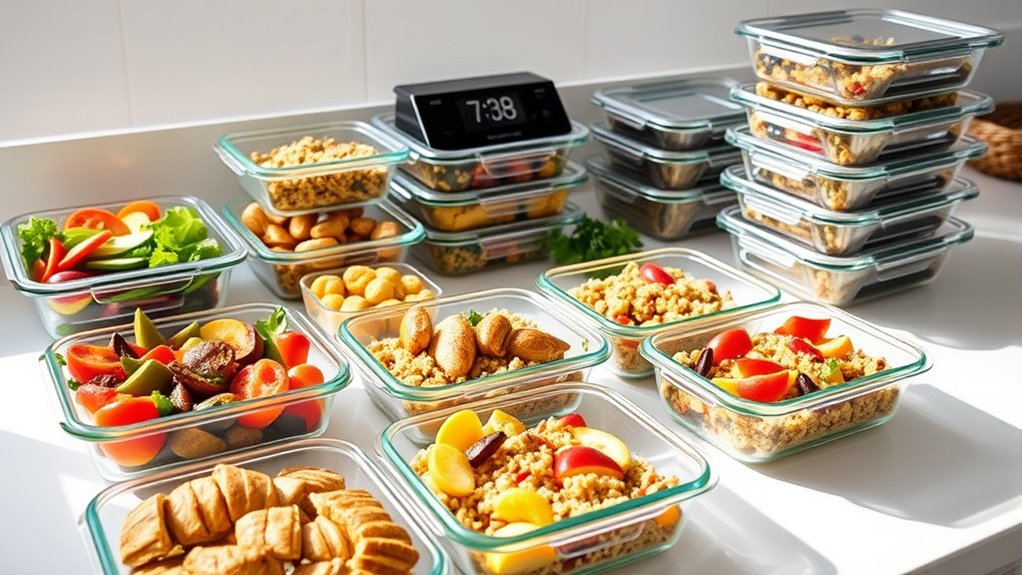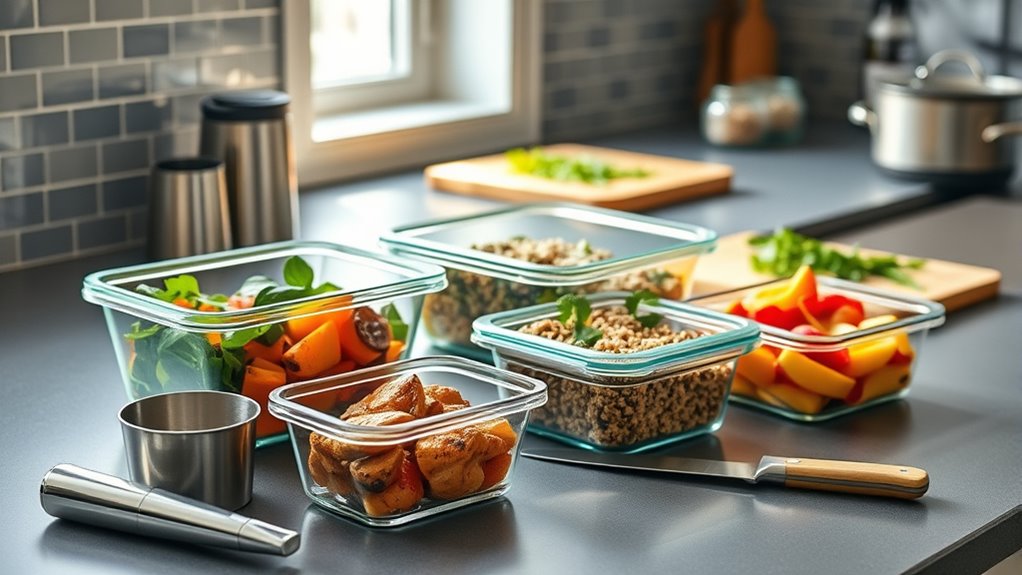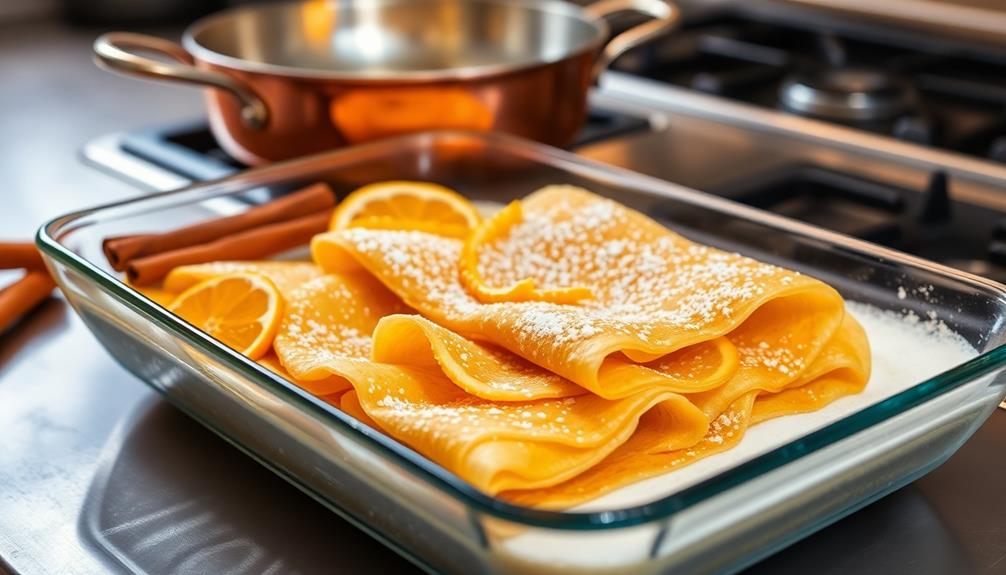Meal prep 101 involves setting aside a few hours to prepare healthy, nutritious meals and snacks in advance. You can cook large batches of proteins, grains, and veggies and store them in portion-sized containers for the week. Incorporate variety to prevent boredom, and include snacks like fruits or nuts to keep energy steady. By planning ahead, you’ll save time daily and stay on track with your healthy eating goals—discover more tips to make your prep seamless.
Key Takeaways
- Set aside dedicated time on weekends for preparing large batches of meals and snacks.
- Use versatile ingredients that can be incorporated into multiple meals to save time and add variety.
- Divide cooked food into individual portions with appropriate containers for easy reheating throughout the week.
- Incorporate healthy snacks like fruits, vegetables, and nuts to maintain energy levels and reduce unhealthy cravings.
- Plan your meals and snacks in advance using meal planning resources to streamline shopping and prep processes.

Have you ever wondered how to save time and eat healthier during busy weeks? One of the best ways to do that is by embracing meal prep, especially through batch cooking. Batch cooking involves preparing large quantities of meals or ingredients at once, then dividing them into portions to be eaten throughout the week. It not only cuts down on daily cooking time but also helps you stick to healthy eating habits. When you set aside a few hours on the weekend to cook in bulk, you’ll have ready-to-eat meals that only need reheating, freeing you from the daily scramble of deciding what to eat or resorting to fast food. Plus, batch cooking allows you to control ingredients, making it easier to incorporate nutritious foods into your diet. Incorporating meal planning into your routine can further streamline your prep process and ensure variety in your meals.
To make your meal prep even more efficient, consider preparing healthy snacks alongside your main dishes. Healthy snacks like cut-up vegetables, fruit portions, nuts, or yogurt can be prepped in advance and stored in the fridge or pantry. Having these snacks ready to go means you’re less likely to reach for less nutritious options when hunger strikes. Incorporating healthy snacks into your weekly plan ensures you stay energized and satisfied between meals, reducing the temptation for sugary or processed foods. When you spend time batch cooking, think about including snack-sized portions of your favorite nutritious foods. For example, baking a batch of granola bars, chopping vegetables for quick salads, or portioning out nuts in small containers can make snacking both convenient and healthy.
Frequently Asked Questions
How Long Can Prepped Meals Be Stored Safely?
You can generally store prepped meals safely for 3 to 4 days, following food safety and storage guidelines. Keep them in airtight containers and refrigerate promptly at 40°F or below. Make sure to reheat thoroughly before eating. If you want to extend shelf life, freeze meals for up to 3 months. Always check for signs of spoilage before consuming, and when in doubt, discard.
What Are the Best Containers for Meal Prep?
You should choose reusable containers with airtight lids for your meal prep. These containers keep your food fresh longer and prevent leaks during storage and transport. Look for options made of glass or durable BPA-free plastic, as they’re safe and easy to clean. Airtight lids guarantee your meals stay fresh, taste great, and avoid spills, making them the best choice for organized, stress-free meal prep throughout the week.
How Can I Prevent Meals From Getting Soggy?
To prevent meals from getting soggy, start with soggy vegetable tips, like roasting or steaming vegetables separately and adding them just before eating. Use airtight containers to keep bread moisture prevention intact, preventing excess humidity from making your bread soggy. Pack wetter ingredients separately, and consider using paper towels or cloths to absorb excess moisture. These techniques help keep your meals fresh and crisp until you’re ready to enjoy them.
Are There Any Foods I Should Avoid Prepping?
Like choosing a crystal ball, avoid prepping highly perishable proteins and delicate fresh produce too far in advance. These foods spoil quickly, risking food safety and quality. Stick to sturdier options like cooked grains, roasted veggies, and canned goods. If you do prep fresh produce, store it separately and add just before eating. This way, your meals stay fresh, tasty, and safe all week long without turning into a culinary time capsule.
How Do I Reheat Meals Without Losing Quality?
To reheat meals without losing quality, use gentle reheat techniques like microwaving on low power or reheating in the oven at a lower temperature. Cover your food to help maintain moisture and flavor. Stir or flip halfway through to ensure even heating. Avoid overheating, which can dry out or overcook your meal. These methods help preserve flavor and texture, making your make-ahead meals taste fresh and delicious.
Conclusion
Now that you know the basics of meal prepping, you’re ready to take control of your week. Plan ahead, stay organized, and enjoy delicious, healthy meals without the daily hassle. Remember, “A stitch in time saves nine”—preparing now makes your busy days much easier. With a little effort, you’ll turn meal prep into a simple habit that saves you time, money, and stress. Happy prepping!









